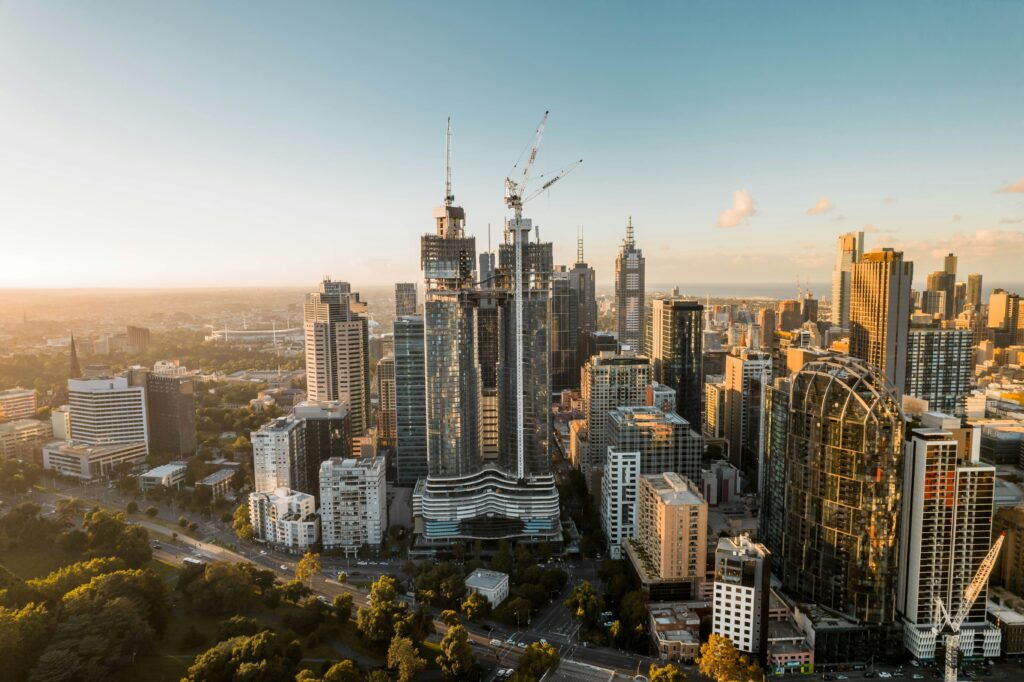Ahead of our participation in the 2024 Asia Society summit, we prepared a paper outlining Australia’s position in the Asian Century, commenting:
“For the Australian economy to be part of the upside of a growing Asia, Australia itself had to become a productive, efficient, value-adding economy. We need to acknowledge and provide the unmet needs of our regional partners. We need to work on building on regional engagement. Long maligned for simply being ‘the lucky country’, Australia needed to be the smart one.”
Short term narratives will always create noise while longer term megatrends prevail.
In the year since, we have observed a great deal of noise. What should be read into the escalations in war and geopolitical tensions? Market volatility? The shift in tariff policy by the Trump White House?
These recent narratives have shifted along with volatility and uncertainty, and the focus on Australian productivity is finally front-and-centre. But universal truths remain unchanged. Asia has reshaped the world in the 21st century and will continue to do so. Australia’s ability to participate in opportunities presented will be through cooperation with our regional partners, serving unmet needs, and lifting national productivity. And it’s not just a one-way street.
Opportunity amid Volatility
Southeast Asia is projected to expand steadily driven by urbanisation, digital transformation, and a rising middle class. This is a megatrend that remains unchallenged against recent volatility. The region remains a significant opportunity for trade, investment, and collaboration with Australia well placed to participate.
Within this it is unmistakable that the recent bout of volatility is seeing supply chains reconfigure, and trade relationships tested. Consider the impact of Trump’s on-again, off-again tariffs. They’ve landed hard—20% to 34% on imports from China, Japan, and South Korea[1]. That’s not just a headline; it’s a policy which can impact trade through the region.
For Australia, the impact has been mixed. We’ve been hit with a flat 10% tariff on most exports to the U.S., with an impending 50% tariff on aluminium.[2] But, is it all bad news? Consider Australian beef exports. Year to date, including through the ‘Liberation Day’ period, beef exports are up by some 30% to both the US and China[3]. Proof that quality product, meeting the needs of your markets, is durable against short term market volatility.
The lasting impact of these tariffs are yet to be seen. And while they are unlikely to blunt the megatrends at play, they also create opportunity. Namely, Asian economies are more actively looking to diversify their supply chains and business relationships. They want partners who are stable, transparent, and committed to long-term collaboration. That’s Australia. We’re more than just another supplier. And in this moment of dislocation, we have a chance to step up.
Is Australia Resilient and Ready?
Australia offers a rare combination of economic strength and social stability. Our financial markets are deep and resilient. Our superannuation system—worth over $3.9 trillion[4]—is a powerhouse of long-term capital. And our corporate sector is agile, innovative, and globally connected.
We’re also resource-rich, not just in minerals and energy, but in ideas. Australian companies can solve problems that matter, backed by a trusted rule of law and stable government.
But being ready and resilient also means productivity needs to lift. Stagnant now for a decade, Australia’s productivity is a drag on living standards and international competitiveness[5]. Piecemeal approaches to productivity and a growing public sector have slowed down productivity growth from the successes of the 1990s and early 2000s.
The conversation is beginning to change. Without a political champion for some time, the upcoming Economic Reform Roundtable may prove a fillip for change as it approaches ways to make our economy more productive, build resilience in the face of global uncertainty, and strengthening the budget to make it more sustainable[6].
Australia’s Housing Affordability Crisis: A Regional Opportunity
Australia’s housing affordability has reached crisis levels, with supply shortages, rising construction costs, and population growth placing immense pressure on the residential sector. The National Housing Accord estimates a shortfall of over 100,000 dwellings by 2027[7], underscoring the urgency of coordinated action. While this is a challenge Australia must lead, it is not one it can overcome alone. It presents a strategic opportunity for Asian partners to participate in what could be Australia’s next major building cycle.
Japanese developers have already begun to play a significant role. Sumitomo Forestry’s acquisition of a majority stake in Metricon[8], Australia’s largest home builder, signals a long-term commitment to addressing housing supply. Similarly, Mitsui Fudosan’s $1.3 billion investment[9] in Mirvac’s Sydney development highlights the scale and seriousness of Japanese capital in the sector.
China’s involvement is equally pivotal. Through its ownership of John Holland[10], one of Australia’s largest infrastructure and construction firms, Chinese capital is deeply embedded in the delivery of major projects—from transport networks to urban renewal initiatives. This integration of Asian expertise and investment is helping to accelerate development timelines and bring global best practices to local challenges.
As Australia seeks to build more homes, faster and smarter, collaboration with trusted Asian partners offers not just financial support, but also innovation, scale, and long-term strategic alignment.
Private Credit and the Aging Asian Population: A Transformational Opportunity
The delivery of high-quality investment products tailored to the needs of Asia’s aging population represents a significant and growing opportunity for providers of retirement income solutions. Across the region, demographic shifts are accelerating: by 2050, one in six people globally will be aged 65 or older[11], with many Asian countries—such as Japan, South Korea, and China—experiencing even faster aging rates.
This “silver tsunami” is reshaping financial markets, driving demand for stable, long-duration income products that can support longer retirements and rising healthcare costs.
At the same time, Asia is witnessing a structural transformation in how capital is sourced and deployed[12]. The global secular trend that has seen private credit surpass traditional banks as the primary source of capital is increasingly evident in Asia. Private credit assets under management globally have grown to over $1.5 trillion, with Asia-Pacific emerging as a key growth region due to its expanding middle class, regulatory reforms, and appetite for alternative financing.
This convergence of demographic pressure and financial innovation is creating fertile ground for retirement-focused investment solutions. Hybrid products that combine income generation, longevity protection, and capital preservation are gaining traction. Financial institutions and insurers are responding by developing tailored offerings that address both the income needs and risk concerns of aging investors.
For Asian asset managers and retirement solution providers, the opportunity lies not only in product innovation but also in building trust and long-term relationships across the region with a generation that is increasingly financially aware and risk-sensitive.
The Lifestyle Dividend
An element that doesn’t always make it into economic reports is the lifestyle dividend. Australia is a great place to live and do business. Our capital cities rank among the most liveable in the world. We have world-class healthcare and infrastructure. We’re safe, diverse, and forward-thinking.
This matters. Not only that, our education system can claim among its alum a growing number of regional business leaders. Leaders with history, experience, and connections back to the Australian business environment.
So, entrepreneurs, researchers, and skilled professionals from across Asia can look to Australia not just for opportunity, but for quality of life. And when they come, they bring capital, networks, and ambition. This is a two-way street of opportunity for developing networks and markets across the region. Australia’s liveability isn’t just a social asset—it’s an economic one.
The Future is still what it used to be
With markets at record prices globally, the recent volatility around tariffs and geopolitical risks is a distraction to the story that continues to be the Asian century. The Australian economy remains well placed to be part of the upside of a growing Asia. We can continue adding value and meeting the unmet needs of our regional partners while building engagement and continuing our long ties into the region. These remain our strengths, and a rich source of our opportunities.
Image credit: Bernd Dittrich, unsplash.com
[1] Trade Compliance Resource Hub
[2] Department of Foreign Affairs & Trade
[3] Australian Broadcasting Corporation
[6] The Australian Government, Treasury
[7] Institute of Public Affairs


